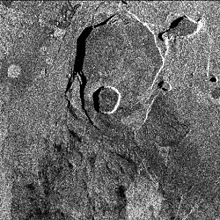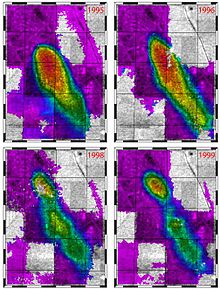Radar interferométrico de apertura sintética
El factor más importante que afecta a la fase es la interacción con la superficie del suelo.Para que la interferometría funcione, cuando se adquieren las imágenes los satélites deben estar tan cerca como sea posible y en la misma posición espacial.For sensors like ERS with a small incidence angle this measures vertical motion well, but is insensitive to horizontal motion perpendicular to the line of sight (approximately north-south).One fringe of phase difference is generated by a ground motion of half the radar wavelength, since this corresponds to a whole wavelength increase in the two-way travel distance.Phase shifts are only resolvable relative to other points in the interferogram.[7] It is this unknown phase delay that prevents the integer number of wavelengths being calculated.However the atmosphere is laterally heterogeneous on length scales both larger and smaller than typical deformation signals.Some research centres and other companies, like the Dutch TU Delft spin-off Hansje Brinker, were inspired to develop their own algorithms which would also overcome InSAR's limitations.Commonly such techniques are most useful in urban areas with lots of permanent structures, for example the PSI studies of European geohazard sites undertaken by the Terrafirma project.provides a ground motion hazard information service, distributed throughout Europe via national geological surveys and institutions.Para generar un interferograma se requieren dos imágenes del radar de apertura sintética; these may be obtained pre-processed, or produced from raw data by the user prior to InSAR processing.At some point, before or after unwrapping, incoherent areas of the image may be masked out.Terrestrial SAR Interferometry (TInSAR) is a remote sensing technique for the displacement monitoring of slopes, rock scarps, volcanoes, landslides, buildings, infrastructures etc. The TInSAR technique is based on the same operational principles of the Satellite SAR Interferometry, pero la apertura sintética del radar (SAR) is obtained by an antenna moving on a rail instead of satellite moving around an orbit.These platforms provided the stable, well-defined orbits and short baselines necessary for InSAR.In 2002 ESA launched the ASAR instrument, designed as a successor to ERS, aboard Envisat.El InSAR puede usarse para medir deformaciones tectónicas, por ejemplo movimientos de tierra, debidos a terremotos.InSAR can be used in a variety of volcanic settings, including deformation associated with eruptions, inter-eruption strain caused by changes in magma distribution at depth, gravitational spreading of volcanic edifices, and volcano-tectonic deformation signals.The technique is now widely used for academic research into volcanic deformation, although its use as an operational monitoring technique for volcano observatories has been limited by issues such as orbital repeat times, lack of archived data, coherence and atmospheric errors.[16] Recently InSAR has also been used to study rifting processes in Ethiopia.[28]realizaron un estudio bibliométrico sobre las tendencias que siguen las publicaciones relacionadas con movimientos de ladera e InSAR.El movimiento y deformación de glaciares, se han medido con éxito utilizando satélites interferométricos.[30] Los interferogramas se pueden utilizar para producir digital elevation maps (DEMs) usando efectos estereoscópicos causados por sutiles diferencias entre posiciones observadas entre las dos imágenes.When using two images produced by the same sensor with a separation in time, it must be assumed other phase contributions (for example from deformation or atmospheric effects) are minimal.This approach was followed by NASA's SRTM mission aboard the space shuttle in 2000.Algunos centros de investigación y otras empresas, desarrollan sus propios algoritmos para poder superar las limitaciones del InSAR.
Fotografía de NASA/JPL-Caltech .

Imagen de NASA/JPL-Caltech .




